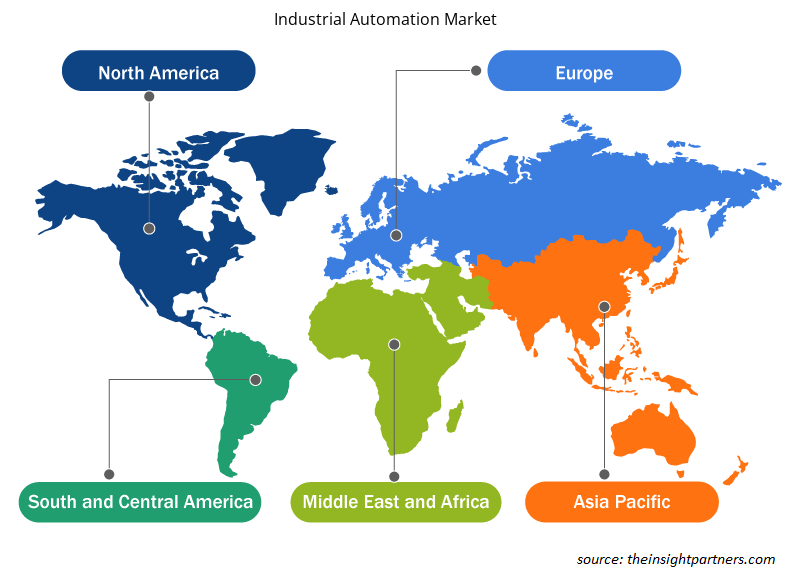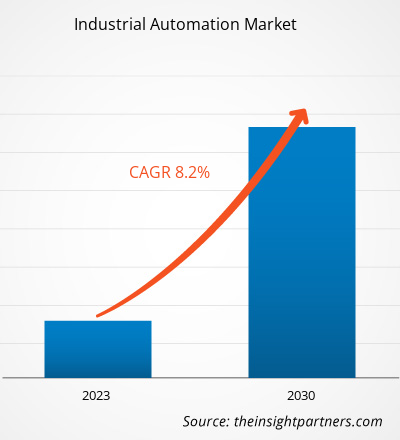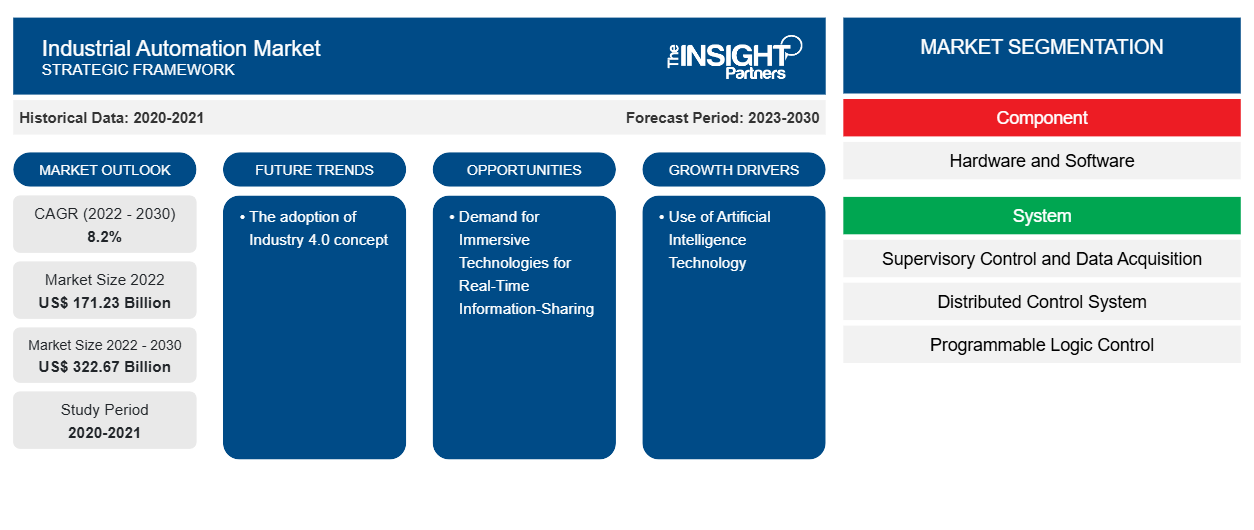工业自动化市场规模预计将从 2022 年的 1712.3 亿美元增至 2030 年的 3226.7 亿美元。预计 2022-2030 年期间市场复合年增长率将达到 8.2%。采用工业4.0 概念可能仍是市场的主要趋势。
工业自动化市场分析
人工智能技术的使用、新兴的互联企业以及对运营效率的关注正在推动市场的发展。由于政府采取了促进工业自动化的有利举措,预计市场在预测期内将增长。此外,对实时信息共享的沉浸式技术的需求以及机器视觉系统与深度学习技术的集成正在为市场创造丰厚的机会。
工业自动化市场概览
工业自动化通过使用机器人、计算机和信息技术等控制系统来操作工业中的各种机械,从而取代人工干预。根据所涉及的操作,工业自动化控制系统分为两类:过程工厂自动化和制造自动化。工业自动化通过使用新的、创新的和集成的技术和服务来提高产品质量、可靠性和生产率,同时降低制造和设计成本。它们具有多种特点,包括高生产率、高质量、灵活性和信息正确性,预计在预测期内将促进工业部门使用自动化。此外,石油和天然气、制造业、化学品和材料、制药和其他行业对自动化解决方案的采用激增,正在推动工业自动化的发展。
定制此报告以满足您的需求
您可以免费定制任何报告,包括本报告的部分内容、国家级分析、Excel 数据包,以及为初创企业和大学提供优惠和折扣
-
获取此报告的关键市场趋势。这个免费样品将包括数据分析,从市场趋势到估计和预测。
工业自动化市场驱动因素和机遇
利用人工智能技术助力市场
人工智能 (AI) 正在以令人难以置信的方式改变制造业。人工智能使机器能够自主学习、适应和做出决策。制造商利用该技术发现资产模式和异常,以优化生产并节省停机时间。例如,将人工智能融入工业机器人和无人机可提高精度并有助于检查、维护和物料处理等活动。这减少了对人为参与的需求,降低了事故风险,提高了维护效率并延长了设备寿命。此外,熟悉操作和设备的运营技术 (OT) 工程师越来越多地使用具有可视化、点击式用户界面 (UI) 的复杂人工智能技术。预构建机器学习 (ML) 应用程序的可用性和工业对自动化的需求正在推动市场的发展。
对实时信息共享沉浸式技术的需求
虚拟现实 (VR) 和增强现实 (AR) 是沉浸式技术,可实现实时信息共享,帮助员工培训、消除人为错误并提高绩效。这意味着 VR 和 AR 可以通过提高员工安全性、提高生产率和减少停机时间增加巨大的商业价值。AR可以通过促进远程协作、远程协助、增强工作指导和 3D 培训等复工措施来帮助工业企业。AR 还有助于制定长期的未来工作战略,旨在缩小技能差距并带来重大收益。增强现实在工作场所变得越来越重要。
- 传输工业物联网 (IIoT) 和传感器数据以改善状态监测、故障排除和维修。
- 查看装配、检查和维护程序的沉浸式 3D 工作说明。
- 获得经验丰富的专业人士的逐步指导和按需帮助。
- 将他们在工厂或现场观察到的情况的评论传递回所连接的数字线程,从而实现整个公司的闭环反馈。
操作员和服务技术人员使用高要求的增强现实来简化操作流程。
工业自动化市场报告细分分析
有助于得出工业自动化市场分析的关键部分是组件、系统和最终用户。
- 根据组件,工业自动化市场分为硬件和软件。2022 年,硬件部分占据了更大的市场份额。
- 根据系统,市场分为监控和数据采集、分布式控制系统、可编程逻辑控制等。监控和数据采集部分预计在预测期内将扩大。
- 根据最终用户,市场分为石油和天然气、汽车、食品和饮料、化工和材料、航空航天和国防等。石油和天然气部门在 2022 年占据了更大的市场份额。
工业自动化市场份额按地区分析
工业自动化市场报告的地理范围主要分为五个区域:北美、亚太、欧洲、中东和非洲、南美和中美。
由于主要参与者的存在,预计亚太地区的市场将在预测期内扩大。欧姆龙公司、三菱电机公司、日立有限公司等公司正在向客户提供技术先进的工厂自动化产品,以提高他们的运营效率。不断扩大的行业和日益普及的工业自动化技术正在推动市场的发展。
工业自动化市场区域洞察
Insight Partners 的分析师已详细解释了预测期内影响工业自动化市场的区域趋势和因素。本节还讨论了北美、欧洲、亚太地区、中东和非洲以及南美和中美洲的工业自动化市场细分和地理位置。

- 获取工业自动化市场的区域特定数据
工业自动化市场报告范围
| 报告属性 | 细节 |
|---|---|
| 2022 年市场规模 | 1712.3亿美元 |
| 2030 年的市场规模 | 3226.7亿美元 |
| 全球复合年增长率(2022 - 2030 年) | 8.2% |
| 史料 | 2020-2021 |
| 预测期 | 2023-2030 |
| 涵盖的领域 |
按组件
|
| 覆盖地区和国家 |
北美
|
| 市场领导者和主要公司简介 |
|
市场参与者密度:了解其对商业动态的影响
工业自动化市场正在快速增长,这得益于终端用户需求的不断增长,而这些需求又源于消费者偏好的不断变化、技术进步以及对产品优势的认识不断提高等因素。随着需求的增加,企业正在扩大其产品范围,进行创新以满足消费者的需求,并利用新兴趋势,从而进一步推动市场增长。
市场参与者密度是指在特定市场或行业内运营的企业或公司的分布情况。它表明相对于给定市场空间的规模或总市场价值,有多少竞争对手(市场参与者)存在于该市场空间中。
在工业自动化市场运营的主要公司有:
- ABB有限公司
- 博世力士乐公司
- 艾默生电气公司
- 日立有限公司
- 霍尼韦尔国际公司
- 三菱电机公司
免责声明:上面列出的公司没有按照任何特定顺序排列。

- 了解工业自动化市场顶级关键参与者概况
工业自动化市场新闻和最新发展
工业自动化市场通过收集一手和二手研究后的定性和定量数据进行评估,其中包括重要的公司出版物、协会数据和数据库。工业自动化市场的一些发展情况如下:
- 2023 年 4 月,艾默生电气以 82 亿美元收购美国国家仪器公司,这是巩固其在工业自动化领域地位的战略举措。该交易符合艾默生对测试和测量增长的追求,利用美国国家仪器公司的软件驱动自动化系统来提高盈利能力和行业多元化。这一举措反映了对先进自动化解决方案的需求激增。(来源:艾默生电气公司,公司网站,2023 年 10 月)
- ABB 印度公司获得了一份重要合同,为安赛乐米塔尔印度新日铁公司位于哈兹拉的先进冷轧厂提供电气化和自动化服务。ABB 的技术旨在提高能源效率、锌消耗优化和耐腐蚀性,符合 AM/NS 印度公司的可持续发展目标。此次合作展示了工业自动化的变革潜力。(来源:ABB Ltd,公司网站,2023 年 6 月)
工业自动化市场报告范围和交付成果
“工业自动化市场规模和预测(2020-2030 年)”报告对以下领域进行了详细的市场分析:
- 工业自动化市场规模及全球、区域和国家层面所有主要细分市场的预测
- 工业自动化市场趋势以及市场动态,如驱动因素、限制因素和关键机遇
- 详细的 PEST/波特五力分析和 SWOT 分析
- 工业自动化市场分析涵盖主要市场趋势、全球和区域框架、主要参与者、法规和最新市场发展
- 行业格局和竞争分析,涵盖市场集中度、热点图分析、知名参与者以及工业自动化市场的最新发展
- 详细的公司简介
- 历史分析(2 年)、基准年、预测(7 年)及复合年增长率
- PEST和SWOT分析
- 市场规模、价值/数量 - 全球、区域、国家
- 行业和竞争格局
- Excel 数据集
近期报告
客户评价
购买理由
- 明智的决策
- 了解市场动态
- 竞争分析
- 客户洞察
- 市场预测
- 风险规避
- 战略规划
- 投资论证
- 识别新兴市场
- 优化营销策略
- 提升运营效率
- 顺应监管趋势























 获取免费样品 - 工业自动化市场
获取免费样品 - 工业自动化市场